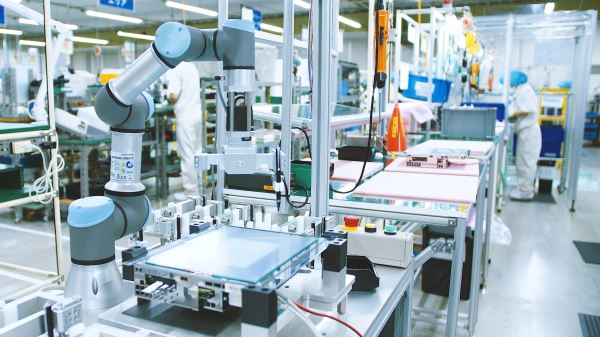Sustainability is now a top priority for companies globally as countries continue to set bold energy and emission targets.
Universal Robots (UR), a world leader in the design and manufacture of collaborative robots, is one company focussed on making its own working practices and production more sustainable.
James McKew Regional President for Universal Robots Asia Pacific, says working with “cobots” can help make manufacturing processes more environmentally sustainable through:
-
Waste reduction
-
Energy consumption
-
Space saving production processes
-
Reshoring initiatives
These are the five ways cobots can help to improve a company’s carbon footprint:
1. Reducing waste
“As part of our commitment to eliminating defects and waste during the manufacturing process, we recently deployed a UR3 cobot at Italian power toolmaker RUPES to help achieve its ‘zero defects’ production target,” explains McKew.
This deployment resulted in reduced waste, lowered operating costs, enhanced productivity, improved working conditions as well as the allocation of workers to higher value tasks.
As the RUPES example shows, one of the most effective ways to reduce waste is to improve the quality of your manufacturing procedures.
“Universal Robots’ commitment to the fact that Quality Matters provides significant reassurance for manufacturers concerned about the sustainability of their operations. In fact, not only are UR cobots manufactured according to high quality standards, but they are proven tools for reducing waste and increasing efficiency across a wide range of manufacturing businesses and processes, from thermoplastics and precision optics manufacturing to welding and automotive production.”
2. Reduced energy consumption
By means of remote monitoring and access, companies can now reduce their energy consumption.
“Reduced travel costs, optimized energy consumption and the streamlining of automation processes through digitlisation all play a key role in driving sustainability,” Mr McKew explains.
The UR+ ecosystem supports digitalisation with a wide range of remote monitoring and access solutions. “Remote monitoring tools allow users to track and monitor cobot performance without having to go on-site.”
Typically accessible via tablet, PC and smartphone, these tools provide a wealth of information on KPIs that can then be used to tweak the cobots’ performance, resulting in improved production efficiency and reduced electricity consumption.
3. Environmentally friendly footprints
Traditional automation typically boasts a large footprint and requires that numerous changes be made to the layout of a production facility.
“In some cases, new construction is required to accommodate the robot,” Mr McKew says. “In contrast, UR’s lightweight cobots offer a small footprint and based on the risk assessment, most cobots require no safety guarding, making them easy to move between applications whilst eliminating costly facility redesigns.”
In a recent success story, Thailand-based company, Benchmark Electronics deployed four UR5 and two UR10e cobots to help improve their operational efficiencies by 25%. This also saved them 10% manufacturing floorspace.
4. Bringing production home
Minimising the distance involved in supply chains reduces transportation costs and is better for the environment. Coupled with uncertainty about the resilience of global supply chains, these environmental concerns have spurred reshoring efforts.
“UR cobots empower these efforts by allowing manufacturers to compete with lower-wage countries whilst keeping production close to home,” says Mr McKew.
5. Maximising energy efficiency in cobot deployments
Generally speaking, cobots are more affordable and consume less energy than their traditional robot counterparts.
There are very simple steps manufacturers can take to minimise energy consumption in their cobot-powered applications.
For example, running a cobot at 70-80% of its maximum speed and payload, where possible, will reduce energy usage and extend the lifespan of the cobot.
“And when it comes to application design, make sure to consider path optimisation strategies as this will also reduce electricity consumption when the cobot is up and running,” Mr McKew says.


